Pediatric Recurrent Vesicular Palmoplantar Dermatitis Presenting with Pyrexia: A Case Report
Nayla Al Khalifa1*, Mazen Raees2, Salman Al Khalifa3, Eman Al Juffairi4
1Resident, Dermatology, Internal Medicine Department, King Hamad University Hospital, Busaiteen, Kingdom of Bahrain
2Consultant in Dermatology and Venereology, Internal Medicine Department, King Hamad University Hospital, Busaiteen, Kingdom of Bahrain
3Consultant Pediatrician and Pulmonologist, Pediatrics Department, King Hamad University Hospital, Busaiteen, Kingdom of Bahrain
4Consultant in Pathology, Pathology Department, King Hamad University Hospital, Busaiteen, Kingdom of Bahrain
*Corresponding Author: Nayla Al Khalifa, Resident, Dermatology, Internal Medicine Department, King Hamad University Hospital, Busaiteen, Kingdom of Bahrain
Received: 12 December 2023; Accepted: 16 January 2024; Published: 23 January 2024
Article Information
Citation: Nayla Al Khalifa, Mazen Raees, Salman Al Khalifa, Eman Al Juffairi. Pediatric Recurrent Vesicular Palmoplantar Dermatitis Presenting with Pyrexia: A Case Report. Archives of Clinical and Medical Case Reports 8 (2024): 13-15.
View / Download Pdf Share at FacebookAbstract
Background: Recurrent palmoplantar dermatitis is a a subtype of chronic hand eczema, presenting with deep-seated palmoplantar vesicles or bullae. Although demographics of recurrent palmoplantar dermatitis in the pediatric age group is obscure, the disorder was found to commonly affect children. Moreover, no standardized global diagnostic and treatment guidelines have been established yet.
Case presentation: In this case report, we present a 5-year-old male patient, known case of nummular dermatitis, presenting with severe palmoplantar bullae and fever.
Conclusions: To date, this is the first case presentation demonstrating a possible viral trigger in pediatric recurrent palmoplantar dermatitis. Further large-scale studies can potentially prove such etiology.
Keywords
Vesicular; Palmoplantar; Dermatitis; Bullae; Pemphigoid
Vesicular articles; Palmoplantar articles; Dermatitis articles; Bullae articles; Pemphigoid articles
Vesicular articles Vesicular Research articles Vesicular review articles Vesicular PubMed articles Vesicular PubMed Central articles Vesicular 2023 articles Vesicular 2024 articles Vesicular Scopus articles Vesicular impact factor journals Vesicular Scopus journals Vesicular PubMed journals Vesicular medical journals Vesicular free journals Vesicular best journals Vesicular top journals Vesicular free medical journals Vesicular famous journals Vesicular Google Scholar indexed journals Syndrome articles Syndrome Research articles Syndrome review articles Syndrome PubMed articles Syndrome PubMed Central articles Syndrome 2023 articles Syndrome 2024 articles Syndrome Scopus articles Syndrome impact factor journals Syndrome Scopus journals Syndrome PubMed journals Syndrome medical journals Syndrome free journals Syndrome best journals Syndrome top journals Syndrome free medical journals Syndrome famous journals Syndrome Google Scholar indexed journals Palmoplantar articles Palmoplantar Research articles Palmoplantar review articles Palmoplantar PubMed articles Palmoplantar PubMed Central articles Palmoplantar 2023 articles Palmoplantar 2024 articles Palmoplantar Scopus articles Palmoplantar impact factor journals Palmoplantar Scopus journals Palmoplantar PubMed journals Palmoplantar medical journals Palmoplantar free journals Palmoplantar best journals Palmoplantar top journals Palmoplantar free medical journals Palmoplantar famous journals Palmoplantar Google Scholar indexed journals Leukemia articles Leukemia Research articles Leukemia review articles Leukemia PubMed articles Leukemia PubMed Central articles Leukemia 2023 articles Leukemia 2024 articles Leukemia Scopus articles Leukemia impact factor journals Leukemia Scopus journals Leukemia PubMed journals Leukemia medical journals Leukemia free journals Leukemia best journals Leukemia top journals Leukemia free medical journals Leukemia famous journals Leukemia Google Scholar indexed journals Dermatitis articles Dermatitis Research articles Dermatitis review articles Dermatitis PubMed articles Dermatitis PubMed Central articles Dermatitis 2023 articles Dermatitis 2024 articles Dermatitis Scopus articles Dermatitis impact factor journals Dermatitis Scopus journals Dermatitis PubMed journals Dermatitis medical journals Dermatitis free journals Dermatitis best journals Dermatitis top journals Dermatitis free medical journals Dermatitis famous journals Dermatitis Google Scholar indexed journals treatment articles treatment Research articles treatment review articles treatment PubMed articles treatment PubMed Central articles treatment 2023 articles treatment 2024 articles treatment Scopus articles treatment impact factor journals treatment Scopus journals treatment PubMed journals treatment medical journals treatment free journals treatment best journals treatment top journals treatment free medical journals treatment famous journals treatment Google Scholar indexed journals CT articles CT Research articles CT review articles CT PubMed articles CT PubMed Central articles CT 2023 articles CT 2024 articles CT Scopus articles CT impact factor journals CT Scopus journals CT PubMed journals CT medical journals CT free journals CT best journals CT top journals CT free medical journals CT famous journals CT Google Scholar indexed journals surgery articles surgery Research articles surgery review articles surgery PubMed articles surgery PubMed Central articles surgery 2023 articles surgery 2024 articles surgery Scopus articles surgery impact factor journals surgery Scopus journals surgery PubMed journals surgery medical journals surgery free journals surgery best journals surgery top journals surgery free medical journals surgery famous journals surgery Google Scholar indexed journals Bullae articles Bullae Research articles Bullae review articles Bullae PubMed articles Bullae PubMed Central articles Bullae 2023 articles Bullae 2024 articles Bullae Scopus articles Bullae impact factor journals Bullae Scopus journals Bullae PubMed journals Bullae medical journals Bullae free journals Bullae best journals Bullae top journals Bullae free medical journals Bullae famous journals Bullae Google Scholar indexed journals Pemphigoid articles Pemphigoid Research articles Pemphigoid review articles Pemphigoid PubMed articles Pemphigoid PubMed Central articles Pemphigoid 2023 articles Pemphigoid 2024 articles Pemphigoid Scopus articles Pemphigoid impact factor journals Pemphigoid Scopus journals Pemphigoid PubMed journals Pemphigoid medical journals Pemphigoid free journals Pemphigoid best journals Pemphigoid top journals Pemphigoid free medical journals Pemphigoid famous journals Pemphigoid Google Scholar indexed journals
Article Details
List of Abbreviations:
Recurrent Vesicular Palmoplantar Dermatitis (RVPD); Dyshidrotic Eczema (DE); Chronic Hand Eczema (CHE); Pediatric CHE (P-CHE); Atopic Dermatitis (AD); Erythrocyte Sedimentation Rate (ESR); Bullous Pemphigoid (BP); Immunoglobulin (Ig); Periodic Acid-Schiff (PAS); Topical Corticosteroids (TCS); Psoralen Plus Ultraviolet-A Radiation (PUVA).
1. Introduction
Recurrent Vesicular Palmoplantar Dermatitis (RVPD), previously known as dyshidrotic eczema (DE) or pompholyx [1,2], is a disorder categorized as a subtype of chronic hand eczema (CHE) [3]. Although demographics of RVPD in children is obscure [1,2,3], more than 1 in 20 children are affected by pediatric CHE (P-CHE) in the United States and Canada [3]. RVPD typically presents with symmetrical deep-seated vesicles or bullae on the lateral fingers, palms, or soles [1,2, 4, 5], usually preceded by itching or paresthesia [2,5]. First described by Fox as a disorder of sweat dysfunction [1], etiology remains mostly idiopathic [1,2,5]. Triggers include hyperhidrosis, dermatophytosis, and contact allergens [1, 2,5]. More importantly, most P-CHE and RVPD were associated with atopic dermatitis (AD) [3,4,5]. RVPD is a clinical diagnosis [1], and histopathology may confirm the disease [2, 4]. Mycological exam, patch testing, and immunofluorescence can rule out other differential diagnoses [1,2,3,6]. RVPD is generally successful to treatment, with treatment options ranging from topical corticosteroids to systemic therapies [3-5].
Because there is no established consensus on RVPD in children [1,2,3], this case aims to demonstrate a possible viral trigger. To date, this is the first case presentation demonstrating RVPD presenting with tense bullae in a febrile, 5-year-old child with nummular dermatitis.
2. Case Presentation
A 5- year-old male, known case of nummular dermatitis, was admitted with fever and tender palmoplantar blisters, which were preceded by erythema and pruritus (Figure 1). On examination, the patient had a fever, measuring 38.6 degrees Celsius, tense palmoplantar bullae, and eczematous discoid patches on the extremities. Routine blood investigations were normal apart from a high eosinophil absolute count of 1.03 x10 9/l and high erythrocyte sedimentation rate (ESR) of 56. Bullous pemphigoid (BP) 180 and 230 immunoglobulin (Ig) G antibodies were negative. Ig A, E, D, G, and M were normal. Throat swab, urine culture, and serology for Coxackie and Enterovirus were normal. Skin biopsy confirmed RVPD (Figure 3 A & B). Sections demonstrated subepidermal bulla filled with scant mixed inflammatory cells, with the roof showing squamous epithelium exhibiting parakeratosis, patchy loss of granular layer and rare dyskeratotic cells. Periodic acid-Schiff (PAS) histochemical stain did not show fungus, and immunofluorescence studies for IgA, IgG, IgM, C1q, C3 and fibrinogen were all negative. No basement membrane or inter-cellular staining was noted.
The patient was initiated on a mixture of Betamethasone Dipropionate and Fusidic acid cream, which resolved the lesions completely within two weeks (Figure 2).

Figure 1: Symmetrical palmar bullae on non-erythematous base

Figure 2: Resolution of bullae

Figure 3 A & B: Skin biopsy shows subepidermal bulla with hyperkeratosis and parakeratosis [arrow], dyskeratosis (circle) and absent granular layer. (Hematoxylin & Eosin stain, A: x20 magnification, B: x200 magnification).
3. Discussion
Since there is no established consensus on RVPD in pediatric patients, and data on clinical phenotype, epidemiology and management guidelines remain variable [1,2,3], this case serves an opportunity to clarify that RVPD may be triggered by a virus. Self-limited or recurrent severe eruption of symmetrical palmoplantar bullae on non-erythematous base differentiated RVPD from dyshidrosiform eruptions, such as contact dermatitis, dermatophytosis, and drug eruptions [1, 2, 3, 5]. Moreover, the atopic status of our patient predisposed him to have RVPD, defined by his discoid eczematous patches. Hence, establishing atopic stigmas, such as eczematide-like patches, atopic family history, elevated serum IgE level or eosinophilia are clues to diagnosing RVPD, which according to a recent cross-sectional study, was associated with atopic dermatitis in 77.8% of patients [1].
Although Coxackie and Enterovirus viral serology were normal, RVPD could have been possibly triggered by a virus as confirmed by the high eosinophil count and high ESR. Furthermore, mycological exam and patch testing may be necessary to exclude dermatophytosis and contact allergy, respectively [2,3,5]. Because localized dyshidrotic bullous pemphigoid (BP) also presents with palmoplantar vesiculobullous lesions, direct immunofluorescence is necessary. Linear deposition of IgG at the dermo-epidermal junction is consistent with dyshidrotic BP [6].
Topical corticosteroids (TCS) remain the first line management for mild to moderate RVPD, and short course of oral prednisolone may be necessary [3,5]. Dupilumab yields complete clearance within four to six weeks in refractory RVPD [3,4]. Studies demonstrated successful outcomes with combination of Botulinum Toxin-A and TCS [5]. Alitretinoin and cyclosporine were discouraged due to premature epiphyseal closure and hypertension, respectively [3]. Complete remission was achieved with oral psoralen plus ultraviolet-A radiation (PUVA) as opposed to other radiotherapy modalities [5].
4. Conclusion
Despite no standardized phenotype, diagnosis, and management guidelines have been established [1,2,3], this case highlights the possibility of a viral trigger in RVPD. Atopy is highly associated with RVPD and can serve as a diagnostic clue when distinguishing RVPD.
Consent
The patient has given their written informed consent for the case and images to be published.
Clinical Message
Dr. Nayla Al Khalifa, Dr. Mazen Raees, Dr. Salman Al Khalifa, and Dr. Eman Al Juffairi aimed to demonstrate the possibility of a viral trigger in RVPD.
Competing Interests
The authors declare they have no competing interests.
Author’s Corner
Dr. Nayla Al Khalifa, Dr. Mazen Raees, Dr. Salman Al Khalifa, and Dr. Eman Al Juffairi are satisfied with this research publication.
Funding
This study has not been funded.
Data Availability Statement
All data underlying the results are available as part of the article and no additional source data are required.
Author Contributions
All authors have accepted responsibility for the entire content of this manuscript and approved its submission. Dr. Nayla Al Khalifa prepared the manuscript, whilst Dr. Mazen Raees and Dr. Salman Al Khalifa supervised the patient’s diagnosis, patient’s management and manuscript. Dr. Eman Al Juffairi provided the histopathology images with the appropriate description.
References
- Scotelaro-Alves HG, Fernandes NC, Ramos-E-Silva M. Clinical profile of recurrent vesicular palmoplantar dermatitis in children and adolescents. Clin Cosmet Investig Dermatol 12 (2019): 23-28.
- Mrudula S, Nandakishore T, Kongbam L, Valsalan B, Nischith V, et al. Recurrent vesicular palmoplantar dermatitis: a clinical study in children and adolescents. Int J Res Dermatol 9 (2023): 73-77.
- Haft MA, Park HH, Lee SS, Sprague JM, Paller AS, et al. Diagnosis and Management of Pediatric Chronic Hand Eczema: The PeDRA CACHES Survey. Pediatr Drugs 25 (2023): 459–466.
- Yali Li, Xiao J, Sun Yi, Fang H, Qiao J, et al. Quick Treatment of Very Severe Refractory Hand and Foot Eczema with Dupilumab: A Case Report and Literature Review. J Asthma Allergy 16 (2023): 1–8.
- Thyssen JP, Menné T. Acute and Recurrent Vesicular Hand Dermatitis. Kanerva's Occupational Dermatology. Springer 1 (2012): 185-195.
- Surabhi D, Sahu P, Jain VK, et al. Dyshidrosiform pemphigoid localized on the hands in a child: a rare occurrence. An Bras Dermatol 92 (2017): 714-716.


 Impact Factor: * 5.3
Impact Factor: * 5.3 Acceptance Rate: 75.63%
Acceptance Rate: 75.63%  Time to first decision: 10.4 days
Time to first decision: 10.4 days  Time from article received to acceptance: 2-3 weeks
Time from article received to acceptance: 2-3 weeks 
